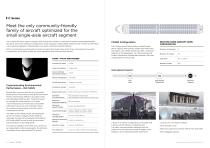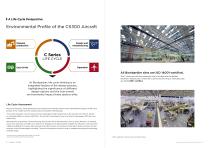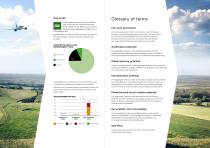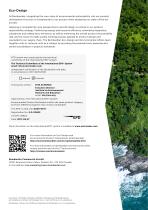 Website:
BOMBARDIER
Website:
BOMBARDIER
Catalog excerpts

CS300 ENVIRONMENTAL PRODUCT DECLARATION
Open the catalog to page 1
In September 2016, we were proud to be the first aircraft manufacturer to release an Environmental Product Declaration for our CS100 aircraft type. Fred Cromer, President, Bombardier Commercial Aircraft This year, we are releasing an Environmental Product Declaration for our CS300 aircraft type. With these two EPDs, we are thrilled to be able to provide you with an overview of the entire C Series family’s environmental performance. This declaration is a testament to Bombardier’s active support of the industry’s climate change goals. As our industry faces global environmental challenges, we...
Open the catalog to page 2
Meet the only community-friendly family of aircraft optimized for the small single-aisle aircraft segment The C Series aircraft is a game-changer from nose to tail. Thanks to a long line of industry-shaping Bombardier aircraft as well as the expertise and experience of the company's highly skilled workforce, the C Series aircraft family is the natural progression of Bombardier's successful commercial aircraft families. With its unmatched environmental scorecard, including the lowest noise levels of any commercial jet currently in production, the C Series is ideal for urban operations and...
Open the catalog to page 3
A Life Cycle Perspective Environmental Profile of the CS300 Aircraft Material production LIFE CYCLE End-of-life All Bombardier sites are ISO 14001-certified. At Bombardier, life cycle thinking is an integrated feature of the design process, highlighting the significance of different design options and the true overall environmental impact these options offer. The C Series aircraft final assembly line in Mirabel and the Belfast (Northern Ireland) site, where the C Series aircraft wing is manufactured, are both LEED* certified. Life Cycle Assessment Resource efficiency, waste generation and...
Open the catalog to page 4
Material production CS300 MATERIAL COMPOSITION The extensive use of advanced structural materials (advanced aluminium and composite), combined with the specific design point contributed to significant weight savings (up to 5,400 kg [12,000 lb] lighter versus re-engined aircraft in its class). The following figure shows the typical material composition of a CS300 aircraft. Design and manufacturing RENEWABLE ENERGY (MJ) Eighty per cent of the environmental impact of an aircraft is determined at the design stage. This fact influenced our decisions from the beginning of the program. In...
Open the catalog to page 5
The operation phase appears to be the major consumer of material resources and non-renewable energy resources (kerosene production process). The upstream phase, which includes raw material extraction and components production, is when more renewable material resources are consumed. Over the last 40 years, the average fuel efficiency of commercial aircraft improved by 70 per cent. However, while this is an impressive achievement for the industry, the environmental footprint of aircraft must continue to be reduced. As fuel burn directly relates to CO2 emissions, it is essential to...
Open the catalog to page 6
Environmental Impact in Detail GaBi database v.6 was used to generate the results. Results are shown using the April 2013 version of the CML2001 impact methodology (https://www.universiteitleiden.nl/en/research/research-output/science/cml-ia-characterisation-factors). All specific data collected through 2012-2016 remains unchanged for 2017 and is valid for a global market. The table shows that most the upstream phase, which includes raw material extraction and components production, is the more important contributor to eutrophication potential impact at 56%. On the other hand, the operation...
Open the catalog to page 7
Glossary of terms Using materials featuring high recyclability rates maximizes the overall recoverability of the CS300 aircraft. Material recycling and energy recovery aggregate to an 82 per cent recoverability rate. Bombardier is involved in research projects to improve the recoverability rate of its aircraft to 100 per cent by 2025. CS300 RECYCLABILITY AND RECOVERABILITY RATE RECYCLABLE Life cycle assessment Life cycle assessment (LCA) is the process used to measure a product's environmental impact at any point for any activity or use over its whole lifetime from raw material...
Open the catalog to page 8
Eco-Design At Bombardier, integrating the core value of environmental sustainability into our product development function is fundamental to our process when designing our state-of-the-art aircraft. Applying a complete life cycle perspective to aircraft design is central to our product responsibility strategy. Maximizing energy and resource efficiency, eliminating hazardous substances and related toxic emissions, as well as enhancing the overall product recoverability rate, are the result of a high quality working process applied to product design and cascaded to our supply chain. The...
Open the catalog to page 9All BOMBARDIER catalogs and technical brochures
-
CRJ1000
2 Pages
-
CRJ900
2 Pages
-
CRJ700
2 Pages
-
CRJ550
2 Pages
-
Q Series
19 Pages
-
C Series CS100 EPD
7 Pages
-
CS300
2 Pages
-
BOMBARDIER C Series
23 Pages
-
Global 8000
2 Pages
-
Q400
5 Pages
-
CS
2 Pages
-
CS 100
2 Pages
-
CRJ series Brochure
25 Pages
-
C series Brochure
23 Pages
-
LEARJET 70
2 Pages
-
CHALLENGER 650
2 Pages
-
CHALLENGER 350
2 Pages


















